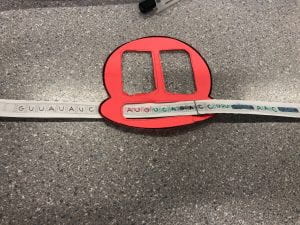In my Anatomy and physiology 12 class, we conducted a lab where we simulated the steps of Protein Synthesis using a paper model.
1. Describe the process of transcription: unwinding, complementary base pairing, separating
The first step of protein synthesis is transcription, this is when the RNA translates the messages from the DNA sequence using ribosomes. Here are the steps of transcription:
A gene (section of DNA) unwinds using the DNA enzyme helicase. Once the two DNA strands have separated, this will allow for the messenger RNA (mRNA) to copy the message from DNA along the nonsense strand, RNA polymerase will connect complementary RNA bases to the DNA by hydrogen bonding. Once the copying has been completed, separation will occur by the mRNA releases the strand of DNA and exists the nucleus via nuclear pores. Protein synthesis continues.
Here is the unzipping/unwinding process
This shows how the mRNA strand was able to transcribe the DNA message through complementary base pairing. Now it has the corresponding bases to proceed to the next step.
Now that the codons are apparent, there is a separation between each of the bases. The mRNA is now able to release the DNA strand which will exit the nucleus.
2. How did today’s activity do a good job of modelling the process of transcription? In what ways was our model inaccurate?
This model gave us the opportunity to greater our understanding of what this process looks like. We were able to see what the process looks like as a whole system. Although it was not accurately sized, there were a couple of other missing components specifically the actual double helix DNA shape in the beginning. There was also no factor of the bases facing outwards on the RNA strand. We were also not able to see how many other enzymes worked in the process of transcription. Another aspect that we did not get to observe would be the representation of the bonding between the backbones and the bases.
3. Describe the process of translation: initiation, elongation, and termination.
There are three stages for translation, initiation, elongation, and termination. when the mRNA arrives at the ribosome the two separated pieces revert together. With the help of rRNA, the ribosome can hold on to the mRNA and begin reading it. Each of the codons is now being read until it reaches the correct start codon (AUG). Now the amino acids can be ordered. The AUG codon is read by the P-site. As this codon is read, a tRNA carrying the eligible amino acid is brought to the current location. The foot of the tRNA has three bases it is the complementary bases of the mRNA, these are known as the anti-codon. This specific sequence allows the tRNA to attach to only 1 mRNA codon. After initiation is over, elongation begins. Now as the strand of mRNA continues to be read, for every codon a tRNA brings over the correct amino acid, beginning the elongation stage. The tRNA initially is placed at the A-site. The amino acid from the P-site and joins the amino acid on the tRNA at the A-site. This changes the shape of the tRNA, completely stopping it from doing its tasks so then it will leave. The ribosome will ensure that the P site is not vacant, and this is when the will transfer to the next codon as well as the growing tRNA amino acid sequence chain. This process of reading each codon, summoning a tRNA, and extending the amino acid chain repeats. From now on, this process will not stop until it encounters a stop codon. This is the termination part of the cycle. There will be no tRNA for a stop codon, so when nothing arrives at the A-site, everything simply falls apart from each other. The ribosome is going to revert to two pieces, the mRNA strand is let go, and the tRNA can release the polypeptide, this is the brand new protein.
This is when the ribosome pieces are assembled and holding on to the mRNA. It’s beginning to read the codons, it has now found the start codon.
The start codon was read in the P-Site, requesting a tRNA with an amino acid attached.
This is the start process of Elongation. The following codon is read, calling over a tRNA with a corresponding anti-codon and amino acid.
The tRNA does not have an amino acid, the shape has changed and it can no longer hold on to its spot in the P-site, and so it leaves.
The ribosome dissaproves of the P-site being empty, so it reaches over for the tRNA and begins reading the next codon.
This process will now repeat until it reaches a stop codon. Nothing will arrive at the A-site as there is no matching tRNA. This begins the process of termination.
This is when everything will release and fall apart from the ribosome. The tRNA releases the polypeptide chain of amino acids which makes a new protein.
4. How did today’s activity do a good job of modelling the process of translation? In what ways was our model inaccurate?
Similar to transcription, this activity brought everything available for visualization. We were able to see the stages and steps of this process. However, there are a couple of things that were missing from this model. For example, we did not get the opportunity to see the joining of the two ribosomes. Another factor that could be deemed inaccurate would be the shape change in the tRNA after the amino acid transfers over. However, we were able to see the basic steps of this cycle and highlight the important stages of Protein Synthesis









